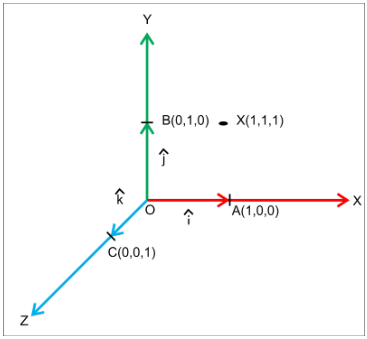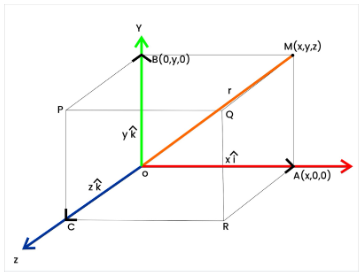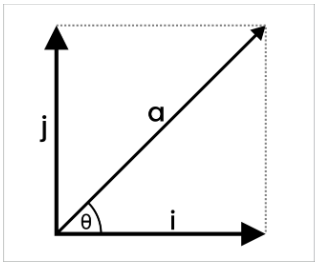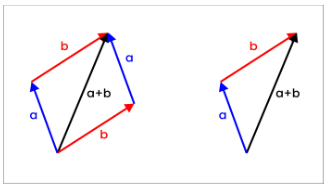Components of a Vector
What is a vector?
There are two categories of physical quantities, namely scalars and vectors. Scalar quantities are straightforward, they represent things like time, speed or distance and only have magnitude, without any direction. On the other hand, vector quantities have both magnitude and direction. For instance, an object’s velocity has both a speed and a direction. Speed is a scalar, but when direction is added, it becomes a vector, which is velocity. Similarly, distance is a scalar quantity, but when direction is added to it, it becomes a vector quantity called displacement, for example, “2 miles south-east.”
Both vectors and scalars have their uses. For instance, if I run around a room and end up back where I started, I might have covered a distance of 50m, but my displacement is 0, which is the null vector, and it has no direction. When calculating how much work I’ve done, I should use distance. But if I want to know my position, I should use displacement. Additionally, the directional component of a vector can be expressed in various ways, such as ‘2 miles south-east’, which is equivalent to saying ‘2 miles on a bearing of 135°’ or ‘1.4 miles east, -1.4 miles north’. The scalar component of a vector is referred to as the modulus of a vector.
When working with a two-dimensional coordinate system, a vector is typically broken down into its x-component and y-component. This means that a vector, represented as V, can be expressed as (vx, vy), with vx and vy being the parts of the vector generated along the x and y axes, respectively. In this article, we’ll be exploring how to find the components of a given vector using formulas for both two-dimensional and three-dimensional coordinate systems.
The definition of components of a vector is that when a vector V is defined in a two-dimensional plane, it can be broken down into two components, namely vx and vy.
Suppose there is an angle θ between a vector V and its x-component. If we draw a line parallel to the y-component (vy), the vector V and its x-component (vx) will form a right-angled triangle.
Using trigonometric ratios, we can determine that:
cos θ = Adjacent Side/Hypotenuse = vx/V
sin θ = Opposite Side/Hypotenuse = vy/V
Here, V is the magnitude of the vector V.
To find the components of a given vector, we can use the following formulas, which were derived in the previous section:
vx = V cos θ
vy = V sin θ
To determine the magnitude of vector V, we can use the Pythagorean theorem:
|V| = √(vx^2 + vy^2)
Orthogonal vectors
Vectors can be easily represented in three dimensions using the coordinate system. But before delving into that, it’s important to understand what an orthogonal representation means.
In terms of coordinate geometry, orthogonal representation refers to parameters that are at right angles to each other. In an orthogonal three-dimensional system, there are three axes perpendicular to each other, representing the x, y, and z axes.
Unit vectors, on the other hand, are vectors that have a magnitude of unit length.
In an orthonormal or orthogonal system, there can be three different unit vectors with one in each direction. These can be represented as follows:
- i represents a unit vector in the x direction
- j represents a unit vector in the y direction
- k represents a unit vector in the z direction
A vector can be represented as the product of its magnitude and its unit vector, as shown by the formula:
v = |v| * u
where v represents the vector, |v| represents its magnitude, and u represents its unit vector.

To represent a vector in space, we can break it down into its components along the three mutually perpendicular axes. This is done by resolving the vector along the x, y, and z axes. We can visualize this by constructing a parallelepiped whose edges, OA, OB, and OC, lie along the three perpendicular axes, with the vector OM as the diagonal. This allows us to see how the vector is oriented in three-dimensional space and provides a convenient way to visualize its components.

Expressing a vector in terms of two other vectors that are usually pointing up and right can be helpful in certain situations. This method is similar to the Cartesian coordinate system, where we use x and y coordinates to locate a point. For instance, an acceleration of 3.4 ms−2 west can be represented as a vertical acceleration of 0 ms−2 and a horizontal acceleration of -3.4 ms−2 east. However, this approach may not always be straightforward, especially for more complex vectors.

It is also important to learn how to add vectors. This skill is necessary to solve problems like “Where am I if I travel 5 miles towards the northwest and then 6 miles towards the east?” or “What is my total acceleration if I accelerate at 3 ms-2 towards the north and 1 ms-2 towards the southeast?” Vectors can be added by aligning them tip-to-tail. In other words, the resulting vector is equivalent to moving along the first vector and then the second vector.The diagram on the left shows how vectors a and b can be added together to produce the resultant vector a+b, where the tail of the first vector is joined to the tip of the last vector, and the vectors are connected. To add two vectors together, the easiest method is to calculate their vertical and horizontal components (if unknown), and then sum them up to obtain two total vertical and horizontal components. After that, Pythagoras’ theorem can be used to find the modulus of the resultant vector, and basic trigonometry can be used to determine its direction.

A vector is a mathematical object that has both magnitude and direction. It is commonly used in physics and engineering to represent quantities like velocity, force, and acceleration.
The components of a vector are the parts of the vector that point along the x-axis and y-axis (or other coordinate axes) of a coordinate system. The x-component is the part of the vector that points along the x-axis, and the y-component is the part of the vector that points along the y-axis.
To find the x-component of a vector, you multiply the magnitude of the vector by the cosine of the angle between the vector and the x-axis. To find the y-component of a vector, you multiply the magnitude of the vector by the sine of the angle between the vector and the y-axis.
The magnitude of a vector is the length of the vector. It is calculated using the Pythagorean theorem: magnitude = sqrt(x^2 + y^2), where x and y are the x-component and y-component of the vector, respectively.
The direction of a vector is the angle it makes with a reference axis. It is usually measured in degrees or radians, and is defined as the angle between the vector and the positive direction of the x-axis (or other reference axis).
Vectors are used in physics to represent physical quantities like velocity, force, and acceleration. By breaking down these quantities into their component vectors, physicists can better understand and analyze the behavior of objects and systems.
Vectors are used in a wide range of applications, including navigation, robotics, video game programming, and graphic design. For example, navigation systems use vectors to calculate the direction and distance between two points, while video game programmers use vectors to determine the movement and position of objects in a game world.






Still got a question? Leave a comment
Leave a comment